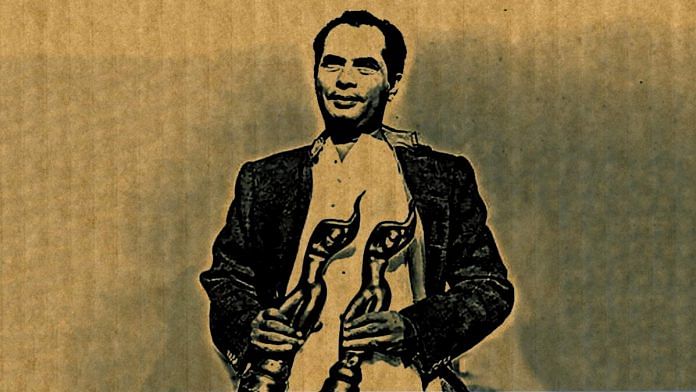Known for his socialist themes and realistic treatment, filmmaker Bimal Roy believed that there is no other medium like cinema to portray human struggle.
Inspired by the Italian neo-realist movement, Roy himself became a source of inspiration for several greats who came after him with his indelible images in films like Do Bigha Zamin (1953), Parineeta (1953), Devdas (1955), Madhumati (1958) and Bandini (1963).
On the filmmaker’s 53rd death anniversary, ThePrint takes a look at the work and life of Roy.
Move to Bombay
Roy was born on 12 July 1909 into a family of landlords in East Bengal (now Bangladesh). He was a student when he lost his father. On a friend’s advice, he migrated to Calcutta (now Kolkata) with his mother and infant brothers. He ended up joining the local film industry.
Roy was always interested in photography and started working with New Theatres as a camera assistant. During this time, he worked under the guidance of filmmaker P.C. Barua.
He directed his first film, Udayer Pathe, while working with New Theatres. The film industry in Calcutta was on a decline at that time and this led Roy to move to Bombay (now Mumbai).
He was accompanied by his team that comprised other future greats, including Hrishikesh Mukherjee, Nabendu Ghose, Kamal Bose, Asit Sen, and later Salil Chaudhury.
Within two years of moving to Bombay, Roy was ready with his first film for the Bombay Talkies. Maa (1952), a story said to be loosely adapted from the Hollywood film Over The Hills (1931), was a story of a “self-sacrificing son and his mother”.
The breakout
A year after Maa’s release, Roy started his own production company and made Do Bigha Zamin (1953). The film, considered to be the first neo-realistic film in Indian cinema, won various accolades at the national and international level, including at the Cannes and the Karlovy Vary festivals.
In Bimal Roy: The Man Who Spoke in Pictures, edited by Roy’s daughter Rinki Roy Bhattacharya, filmmaker Shyam Benegal said, “The film which hit me between my eyes was Do Bigha Zamin. I was a schoolboy then. It had struck me as different from anything I had seen before. No film had ever made me discover its maker until then. Do Bigha Zamin was the film that made me look for the name.”
Do Bigha Zamin also marked the beginning of the legacy of Roy as a director who made films on a wide range of subjects.
Also read: Remembering Nirupa Roy, Indian cinema’s ‘Goddess’ who became its most popular mother
‘Making human beings seem as human beings’
In films like Parineeta, Biraj Bahu (1954), Devdas, Madhumati, Parakh (1960), Prem Patra (1962) and Bandini, Roy dealt with complex subjects, concerned with the social morality of the time.
Madhumati, among his more popular works, was a reincarnation noir thriller written by filmmaker Ritwik Ghatak. The film, which featured great performances by actors Dilip Kumar and Vyjayanthimala, has inspired several Hindi films over the years, including Subhash Ghai’s Karz (1981) and Farah Khan’s Om Shanti Om (2007).
One of Roy’s most acclaimed works remains his adaptation of Sarat Chandra Chattopadhyay’s Devdas, which was earlier made into a film by his guru P.C. Barua. Featuring a defining performance by Kumar, Roy’s Devdas is the most faithful adaptation of the novella and an inspiring work of art.
“Bimal Roy was making human beings seem as human beings,” Benegal said in the book. He also spoke about how the protagonists in Roy’s films are not depicted as heroes. Roy’s films deviated from the trend of making characters look “larger than life or reduce them”.
Through his oeuvre of cinema, Roy laid the foundation of realism and complexity in mainstream, popular fare that had not been quite seen that way before him. His major career spanned only a decade, but it saw Roy leaving an indelible imprint on India cinema.
Roy succumbed to cancer on 8 January 1966 at the age of 56.
Also read: Rajesh Khanna, Bollywood’s first superstar who charmed an entire generation




Bimal Roy is probably the best director of Hindi Cinema. How many greats became his assistants ? Hrishikesh Mukherjee, Gulzar and Basu Bhattacharya.
Bimal Roy is my favourite. Lovely write up. Touched every nuance of his directorial ability. I am yet to come across a better article with my father being an exception. Would like to share his take on Bimal Roy